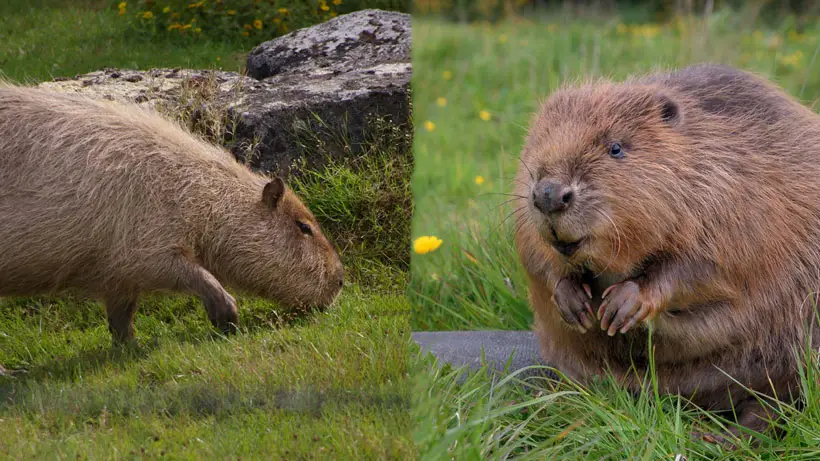Capybara vs. Beaver: Key Differences in Behavior and Characteristics
Capybaras and beavers are two of the most interesting rodents in the animal kingdom. While they may seem similar in some ways, key differences in their behavior and characteristics set them apart.
What are the differences between capybara vs. beaver? Capybaras are the largest rodents in the world and have a semi-aquatic lifestyle. They live in South America and create shallow burrows near water bodies. Conversely, beavers are smaller and are found throughout North America, Europe, and Asia and construct dams and lodges.
By reading on, you will learn about the physical characteristics, behavioral differences, and habitat preferences of capybaras and beavers. You will also gain an understanding of how these differences impact their habitats and what can be done to mitigate any damage caused.
Overview of Differences Between Capybara vs. Beaver

There are a number of key differences in the behavior and physical characteristics of these rodents. Here is a table summarizing the differences between capybaras and beavers.
| Characteristics | Capybara | Beaver |
|---|---|---|
| Size | Up to 140 lbs, 4 ft | Up to 50 lbs, 3 ft |
| Fur Color | Tan | Dark brown |
| Tail Type | Non-existent | Paddle-like |
| Tail Shape | Small, round, blunt | Large, flat, paddle-like |
| Teeth | Simple | Sharp, chisel-like incisors |
| Physical Abilities | Excellent swimmer, a skilled climber | Strong on land, can build dams and lodges |
| Burrowing Habits | Shallow burrows near the water’s edge | Construct complex dams and lodges |
| Social Behaviors | Highly social, live in groups | Solitary or in small family groups |
| Communication | Barks, whistles, grunts, scent marking | Grunts, whistles, alarm calls, tail slapping |
| Diet and Digestion Method | Herbivore, cud-chewing | Herbivore, gnaws through tough plant material |
| Habitat Preference | South America, various habitats | North America, Europe, Asia, freshwater habitats |
| Water Body Preference | Rivers, lakes, ponds, wetlands | Freshwater habitats, build dams to create still water pools |
| Activity Preference | Diurnal | Nocturnal |
| Mating and Breeding Behavior | Polygamous, females initiate mating, vocalizations and scent marking involved | Monogamous, males initiate mating, tail-slapping and scent marking involved |
| Reproduction | 5-8 young per litter | 2-4 kits per litter |
| Lifespan | 8-10 years | 10-15 years |
1. Capybara vs. Beaver: Physical Characteristics
Capybaras and beavers share a few common physical characteristics but differ significantly in many ways. Here is an in-depth exploration of the unique physical characteristics of capybaras and beavers.
Size
Capybaras are the largest rodents in the world and can weigh up to 140 pounds. They measure up to 4 feet in length and stand about 2 feet tall at the shoulder.
In contrast, beavers are smaller, with an average weight of 40-50 pounds. They measure up to 3 feet long and stand about 2 feet tall.

Fur Color
Capybaras have short, rough furs that are tan in color. Their fur helps them stay warm and dry in the water.
Beavers, on the other hand, have thick, waterproof fur that is typically dark brown. Their fur comprises two layers- the outer guard hairs and the inner soft underfur. The underfur is what keeps them warm and dry.
Tail Type and Shape
One of the beavers’ most distinctive physical features is their flat, paddle-like tail. The flat shape of the beaver’s tail allows it to function as a rudder when swimming and helps with stability when standing upright. It is also used as a tool for communication, slapping the water to alert other beavers of danger.
In contrast, Capybaras have non-existent small, round tails with blunt tips, while beavers have large, flat tails shaped like paddles. The capybara’s tail is not used for anything other than balance, while the beaver’s tail serves many purposes.
Teeth
Another physical difference between the capybara and beaver is their teeth. Beavers have powerful teeth that never stop growing. Their two front teeth, called incisors, are sharp and chisel-like, which they use to gnaw through trees and other hard objects.
In contrast, capybaras have simple teeth adapted to their herbivorous diet, primarily grasses, aquatic plants, and fruits.
Physical Abilities
Capybaras are excellent swimmers who can stay underwater for up to five minutes. They are also skilled at climbing and can easily scale steep embankments to escape predators.

Beavers are not as strong swimmers as capybaras but make up for it with their exceptional abilities on land. Beavers can build dams that can redirect entire rivers and create large ponds, altering the course of the water flow in their habitats.
They are also skilled at building lodges, which serve as their homes and provide protection from predators.
Burrowing Habits
Capybaras barely dig shallow burrows near the water’s edge, which they use for shelter and protection. These burrows are usually around 3 feet deep and can have several entrances. They also inhabit burrows that other animals have already dug.
In contrast, beavers are well-known for their ability to construct complex dams and lodges.
They use sticks, mud, and other materials to build dams across rivers or streams, which creates a pond or lake that serves as their home. They also build lodges within their dams, providing shelter and protection.
2. Capybara vs. Beaver: Behavioral Differences
Capybaras and beavers have different social behaviours and habitual methods. They include the following.
Social Behaviors and Communication
Capybaras are highly social animals and live in groups of up to 20 individuals. Within these groups, they establish dominance hierarchies, with the dominant male and female leading the group. They communicate with each other using a range of vocalizations, including:
- Barks
- Whistles
- Grunts
They also use scent marking to communicate, rubbing their scent glands on objects to leave a chemical signal for other capybaras.

At the same time, beavers are solitary animals and live alone or in small family groups consisting of a mating pair and their offspring. They establish territories and defend them from other beavers using scent marking and physical aggression.
Beavers communicate with each other using a range of vocalizations, including:
- Grunts
- Whistles
- Alarm calls
They also use their tails to slap the water to alert other beavers of danger.
Diet and Digestion Method
Capybaras are herbivores and mainly feed on grasses and aquatic vegetation. Their unique digestive system allows them to extract nutrients from tough and fibrous plant material.
Capybaras can regurgitate and rechew their food, a process called “cud-chewing,” which helps break down the plant material and extract more nutrients.
On the other hand, beavers are also semi-aquatic herbivores. But they have a more varied diet, including leaves, bark, and twigs of deciduous trees such as aspen and poplar. They have large incisors that allow them to gnaw through the tough outer bark of trees, which they use for food and building material.

Habitat Preference and Location
Capybaras are native to South America and are found in various habitats, including:
- Savannas
- Rainforests
- Wetlands
They are semi-aquatic and are often found near rivers, lakes, and ponds.
However, beavers are found in North America, Europe, and Asia and prefer freshwater habitats such as:
- Rivers
- Streams
- Ponds
They build dams to create still-water pools, which protect them from predators and give them easier access to food.
Water Body Preference
Capybaras are known to prefer still or slow-moving water sources, such as rivers, ponds, and marshes. They are excellent swimmers who can stay submerged for up to five minutes.
On the other hand, beavers are more commonly associated with flowing water sources, such as streams and rivers. They are exceptional builders and can create dams to control the water flow and create ponds that provide them with food and shelter.

Activity Preference
Capybaras are diurnal animals, which means they are active during the day and rest at night. They spend most of their time grazing on grasses and other vegetation, which they find near the water’s edge.
Beavers are primarily nocturnal animals, so they are active at night and rest during the day. They spend most of their time foraging for food, which they find in and around the water.
3. Capybara vs. Beaver: Mating, Reproduction and Lifespan
Here are the key differences between capybaras and beavers regarding their mating habits, reproduction and lifespan.
Mating Behavior and Ritual
Capybaras are polygamous animals, and during the breeding season, dominant males mate with several females. Males will approach females and attempt to mount them to initiate mating.
If a female is not receptive, she will move away or bite the male. Once mating is successful, the male and female may remain together briefly before separating.

Beavers are monogamous animals and form lifelong partnerships with their mates. During the mating season, a male beaver will scent mark and vocalize to attract a female.
The pair will then engage in a courtship ritual, which includes swimming together and nuzzling. Once the pair has bonded, they will mate and then work together to build a lodge and prepare for the arrival of their offspring.
Mating Season
The mating season for capybaras varies depending on the region. It can occur throughout the year in some areas and is restricted to a specific season in others. The breeding season for capybaras generally lasts from late fall to early spring.
On the other hand, Beavers typically mate during the winter months from January to March, with the season’s peak in February.

Reproduction and Parental Care
Capybaras have a gestation period of around 130 days, and females give birth to litters of one to eight young, with an average of four.
The young are born precocial, meaning they are fully developed and can move around shortly after birth. Capybara mothers provide extensive parental care, nursing their young and protecting them from predators.
Beavers have a gestation period of around 128 days and give birth to litters of one to nine young, with an average of four. The young, called kits, are born altricial, meaning they are underdeveloped and require significant care and attention from their parents.
Both male and female beavers provide parental care, with the father actively raising the kits.
Lifespan
Capybaras have a lifespan of around 8-10 years in the wild and up to 12 years in captivity. Beavers have a lifespan of around 10-12 years in the wild and up to 20 years in captivity.
If you’re comparing capybaras and beavers, you might also be interested in our articles on whether capybaras can be potty trained and capybaras as pets. Our article on whether capybaras can be potty trained explores the possibilities of teaching these animals to use specific areas for elimination. Additionally, if you’re considering capybaras as pets, our article provides insights into their care, behavior, and suitability as domesticated animals. By reading these articles, you’ll learn more about capybaras’ potential for potty training and the aspects to consider when keeping them as pets.FAQs
Here are a few more questions you might be asking about these two giant rodents.
Q1: Are capybaras and beavers endangered?
Capybaras are not endangered but are classified as species of the least concern. Beavers were once hunted to near extinction but have since recovered and are now considered a species of least concern.
Q2: Are capybaras and beavers endangered?
Capybaras are not endangered but are classified as a species of least concern. Beavers were once hunted to near extinction but have since recovered and are now considered a species of least concern.
Q3: Are capybaras related to beavers?
No, they are not closely related. Capybaras and beavers are both rodents, but they belong to different families. Capybaras belong to the family Caviidae, while beavers belong to the family Castoridae.
Conclusion
Understanding the differences between capybara vs beaver is crucial for effective wildlife management and pest control. By knowing their distinct differences, we can develop better strategies for managing their populations and mitigating their impacts on human activities.
Further research is needed to fully comprehend the complexities of capybara and beaver behaviour and their ecological roles. As you continue to expand your knowledge, you can also explore ways to prevent capybara and beaver damage to waterways and other resources.




